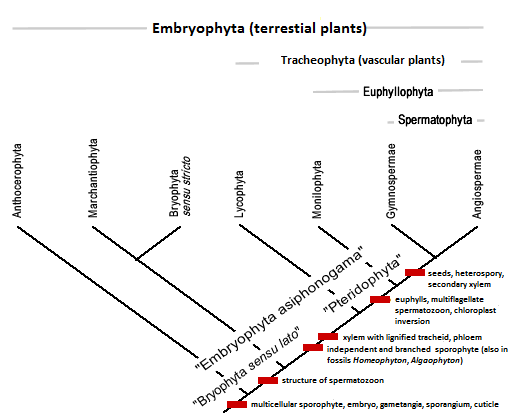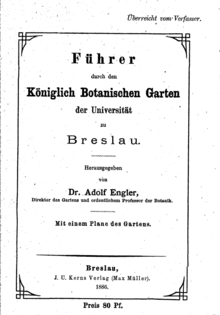Engler system
One of the prime systems of plant taxonomy, the Engler system was devised by Adolf Engler (1844–1930), and is featured in two major taxonomic texts he authored or coauthored. His influence is reflected in the use of the terms "Engler School" and "Engler Era". Engler's starting point was that of Eichler who had been the first to use phylogenetic principles, although Engler himself did not think that his was.[1]
Engler's works
His modified Eichler schema first appeared in 1886 in his Guide to Breslau Botanic Garden[2] (of which he was the director) and was expanded in his Syllabus der Pflanzenfamilien in 1892.[3] This reflected the new post-Darwinian perspective. Engler's Syllabus first appeared in 1892 with the title Syllabus der Vorlesungen über specielle und medicinisch-pharmaceutische Botanik. Many subsequent editions have appeared since, and it was continued after Engler's death in 1930. The most recent edition was the 13th in 2009.[4]
The other major work was Die Natürlichen Pflanzenfamilien (1887-1915) written with Karl Anton Prantl in 23 volumes.[5] An incomplete second edition was issued in 28 parts (1924-1980).[6] Die Natürlichen Pflanzenfamilien consisted of a complete revision of plant families down to generic level and often even further.[7] Die Natürlichen Pflanzenfamilien is still considered one of the few true World Floras.[7][8] Finally there was the also incomplete Das Pflanzenreich (1900–1968),[9] a multi-authored work which attempted to provide a modern version of Linnaeus' Species Plantarum (1753).[7] The Engler system rapidly became the most widely used system in the world.[10]
References to the Engler system may imply an edition of the Syllabus der Pflanzenfamilien or Die Natürlichen Pflanzenfamilien. The different approaches between the two works and the different editions has resulted in inconsistencies in the descriptions of the system. A number of references to the Engler system actually refer to later revisions ('modified Engler system') undertaken by Melchior and colleagues, the 12th edition of the Syllabus (1964). Many of the world's herbaria have been organised on the Engler system, particularly in North America and in Europe other than Britain.[7][11]
Plants were considered to form a number of divisions (Abteilung), the number of which continually changed but initially (1886) was four and in 1919 was thirteen. Many of these referred to lower life forms such as bacteria and algae that would not necessarily be considered as plants today. Initially higher plants (Embryophyta or terrestrial plants) were considered in two divisions, Embryophyta Asiphonogama (bryophytes, pteridophytes) and Embryophyta Siphonogama (Spermatophytes: gymnosperms, angiosperms), but were later subdivided. Embryophyta Siphonogama replaced the older term Phanerogamae, and the classes were further divided into groups of families, called orders. Engler followed Eichler's phylogeny, placing the monocotyledons before the dicotyledons, and within the latter the Archichlamydeae before the Metachlamydeae.[7] While the groupings were largely based on those of Bentham and Hooker, the ordering was very much based on the concept of the primitive plant and those that were derived from these.

| German | Latin | English |
|---|---|---|
| Abteilung | divisio | Division |
| Unterabteilung | subdivisio | Subdivision |
| Klasse | classis | Class |
| Reihe | ordo | Order |
| Unterreihe | subordo | Suborder |
| Fam. | familia | Family |
| Unterfam. | subfamilia | Subfamily |
| Gruppe (§) | tribus | Tribe |
| Gattung | genus | Genus |
| Art | species | Species |
Führer durch den Königlich botanischen Garten (Engler 1886)

Synopsis[2]
- Division Mycetozoa (Myxomycetes)
- Division Thallophyta
- Subdivision Schizophyta
- Subdivision Algae
- Class Bacilleriaceae (Diatomaceae)
- Class Chlorophyceae
- Class Phaeophyceae
- Class Rhodophyceae (Florideae)
- Subdivision Fungi
- Class Phycomycetes
- Class Ustilagineae
- Class Ascomycetes (Lichenes)
- Subdivision Characeae
- Division Zoidogamae (Archegoniatae)
- Subdivision Bryophyta
- Subdivision Pteridophyta
- Class Filicinae (2 orders) p. 11
- Class Equisetinae
- Class Lycopodinae
- Division Siphonogamae (Phanerogamae, Anthophyta)
- Subdivision Gymnospermae (Archispermae)
- Class Cycadinae
- Class Coniferae
- Class Gnetales
- Subdivision Angiospermae (Metaspermae)
- Class Monocotyledoneae (10 orders) p. 18
- Class Dicotyledoneae
- Subclass Archichlamydeae (Choripetalae, Apetalae) (25 orders) p. 30
- Subclass Sympetalae (10 orders) p. 57
- Subdivision Gymnospermae (Archispermae)
Division Zoidogamae (Archegoniatae)
- Subdivision Bryophyta
- Class Hepaticae
- Class Musci frondosi
- Subdivision Pteridophyta
- Class Filicinae (2 orders)
- Order Filices p. 11
- Order Hydropterides p. 13
- Class Equisetinae
- Class Lycopodinae
- Class Filicinae (2 orders)
Division Siphonogamae (Phanerogamae, Anthophyta)
Subdivision Gymnospermae (Archispermae)
- Class Cycadinae
- Class Coniferae
- Class Gnetales
Subdivision Angiospermae (Metaspermae)
- Class Monocotyledoneae (10 orders) p. 18
Class Monocotyledoneae
- Order Pandanales (3 families) p. 18
- Order Helobiae (Fluviales) (9 families) p. 18
- Order Glumiflorae (2 families) p. 18
- Family Gramineae
- Family Cyperaceae p. 21
- Order Principes (1 family) p. 21
- Order Synanthae (1 family) p. 22
- Order Spathiflorae (2 families) p. 22
- Order Farinosae (11 families) p. 23
- Order Liliiflorae (Solido-albuminatae) (8 families) p. 23
- Family Juncaceae p. 23
- Family Liliaceae (10 subfamilies) p. 23
- Subfamily Melanthioideae p. 24
- Subfamily Herrerioideae
- Subfamily Asphodeloideae
- Subfamily Allioideae p. 25
- Subfamily Liliodeae p. 25
- Subfamily Dracaenoideae
- Subfamily Asparagoideae p. 26
- Subfamily Ophiopogonoideae
- Subfamily Luzuriagoideae
- Subfamily Smilacoideae p. 26
- Family Haemodoraceae
- Family Amaryllidaceae (3 subfalies) p. 26
- Subfamily Amaryllidoideae p. 26
- Subfamily Agavoideae p. 26
- Subfamily Hypoxidoideae
- Family Velloziaceae p. 27
- Family Taccaceae
- Family Dioscoreaceae
- Family Iridaceae (3 subfamilies) p. 27
- Subfamily Crocoideae
- Subfamily Iridoideae
- Subfamily Ixioideae
- Order Scitamineae p. 28
- Order Microspermae
Class Dicotyledoneae
- Subclass Archichlamydeae (Choripetalae, Apetalae) (25 orders) p. 30
- Subclass Sympetalae (10 orders) p. 57
Die Natürlichen Pflanzenfamilien (Engler and Prantl 1887–1915)
Synopsis of first edition [5]
- Myxothallophyta (Myxomycetes) [I (1)] 1897
- Euthallophyta
- Embryophyta Zoidiogama (Archegoniatae) (later Embryophyta Asiphonogama) [I (3)] 1909
- Embryophyta Siphonogama [II (1)] 1889
Syllabus der Pflanzenfamilien (Engler ed. 1892–)
Synopsis of first edition [12]
- Myxothallophyta
- Euthallophyta
- Embryophyta Zoidiogama (Archegoniatae)
- Embryophyta Siphonogama (Phanerogamae)
Notes
References
- Bhattacharyya 2005, Linnaeus' System of Classification and Thereafter p. 59.
- Engler 1886, Systematische Abteilung pp. 10–11.
- Naik 1984.
- Frey, Stech & Fischer 2009.
- Engler & Prantl 1887–1915.
- Frodin 2001, p. 98.
- Stace 1989, Post-Darwinian phylogenetic systems p. 31.
- Bhattacharyya 2005.
- Engler 1900–1968.
- Walters & Keil 1996, Traditional phylogenetic classification p. 469.
- Walters & Keil 1996, Final stages of processing specimens p. 74.
- Engler 1892.
Bibliography
Works by Engler
- Engler, Adolf (1886). Führer durch den Königlich botanischen Garten der Universität zu Breslau (in German). J.U. Kerns Verlag (Max Müller). Retrieved 2 May 2015.CS1 maint: ref=harv (link)
- Engler, Adolf; Prantl, Karl, eds. (1887–1915). Die Natürlichen Pflanzenfamilien nebst ihren Gattungen und wichtigeren Arten, insbesondere den Nutzpflanzen, unter Mitwirkung zahlreicher hervorragender Fachgelehrten (in German). 33 parts (Abteilungen) in 23 volumes. Leipzig: W. Engelmann. Retrieved 31 January 2014.CS1 maint: ref=harv (link) (At BHL, also Google Books, III (6–8))
- Engler, Adolf (1892). Syllabus der Vorlesungen über specielle und medicinisch-pharmaceutische Botanik. Eine Uebersicht über das gesammte Pflanzensystem mit Berücksichtigung der Medicinal-und Nutzpflanzen (in German) (1st ed.). Berlin: Gebrüder Borntraeger Verlag. p. 143. Retrieved 29 April 2015.CS1 maint: ref=harv (link)
- Frey, Wolfgang; Stech, Michael; Fischer, Eberhard, eds. (2009). A. Engler's Syllabus der Pflanzenfamilien Part 3: Bryophytes and seedless vascular plants (13th ed.). Berlin: Borntraeger. ISBN 978-3-443-01063-8. Retrieved 29 April 2015.CS1 maint: ref=harv (link) Google Books
- Engler, Adolf, ed. (1900–1968). Das Pflanzenreich: regni vegetablilis conspectus (in German). Leipzig: W. Engelmann. Retrieved 3 May 2015.CS1 maint: ref=harv (link)
Works about Engler
- Frodin, David G. (2001) [1984]. Guide to Standard Floras of the World: An Annotated, Geographically Arranged Systematic Bibliography of the Principal Floras, Enumerations, Checklists and Chorological Atlases of Different Areas (2nd ed.). Cambridge University Press. ISBN 9781139428651. Retrieved 28 April 2015.CS1 maint: ref=harv (link)
- Morley, Thomas (1984). "An Index to the Families in Engler and Prantl's "Die Naturlichen Pflanzenfamilien'". Annals of the Missouri Botanical Garden. 71 (1): 210–228. JSTOR 2399064.CS1 maint: ref=harv (link)
- Stace, Clive A. (1989) [1980]. Plant taxonomy and biosystematics (2nd. ed.). Cambridge: Cambridge University Press. ISBN 9780521427852. Retrieved 29 April 2015.CS1 maint: ref=harv (link)
- Carter, Humphrey G. (1913). Genera of British plants arranged according to Engler's Syllabus der pflanzenfamilien (Seventh edition 1912). Cambridge University Press. Retrieved 10 February 2014.CS1 maint: ref=harv (link)
- Bhattacharyya, Bharati (2005). Systematic botany. Harrow: Alpha Science International Ltd. ISBN 9781842652510. Retrieved 29 April 2015.CS1 maint: ref=harv (link)
- Naik, V.N. (1984). Taxonomy of Angiosperms. New Delhi: Tata McGraw-Hill Education. ISBN 9780074517888.CS1 maint: ref=harv (link)
- Stuessy, Tod F. (2009). Plant taxonomy: the systematic evaluation of comparative data (2nd ed.). New York: Columbia University Press. ISBN 9780231518642. Retrieved 5 May 2015.CS1 maint: ref=harv (link)
- Walters, Dirk R.; Keil, David J. (1996) [1975]. Vascular plant taxonomy (4th ed.). Dubuque, Iowa: Kendall/Hunt Pub. Co. ISBN 9780787221089. Retrieved 30 April 2015.CS1 maint: ref=harv (link)
External links
- Engler & Prantl system
- Bhandary, J. Engler & Prantl system of classification. 2013 Slide show
- George H. M. Lawrence TAXONOMY OF VASCULAR PLANTS: Part One 03. History of Classification: Theories
| Wikimedia Commons has media related to Adolf Engler. |
| Wikimedia Commons has media related to Das Pflanzenreich. |
| Wikimedia Commons has media related to Die naturlichen Pflanzenfamilien. |
Note: This is a selected list of the more influential systems. There are many other systems, for instance a review of earlier systems, published by Lindley in his 1853 edition, and Dahlgren (1982). Examples include the works of Scopoli, Ventenat, Batsch and Grisebach.